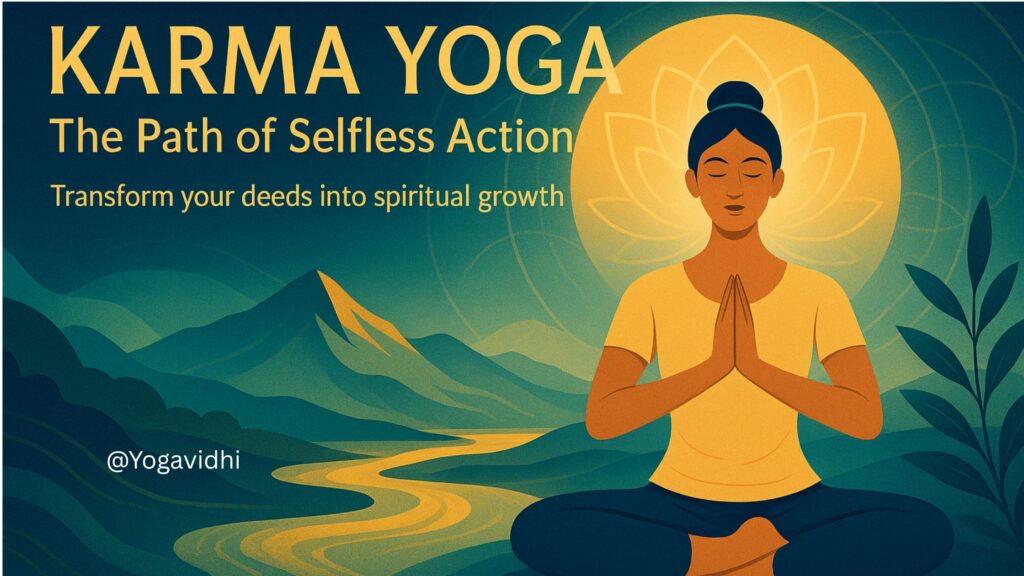In today’s fast-paced world, where personal gain often overshadows collective well-being, the ancient philosophy of Karma Yoga emerges as a profound spiritual path that offers clarity, balance, and purpose. Rooted in selfless service and detached action, Karma Yoga teaches us that every deed—when performed with the right intention—can lead to inner growth and liberation.
Whether you’re seeking spiritual fulfillment or simply a more meaningful life, Karma Yoga provides a time-tested roadmap for living consciously and compassionately.
Karma Yoga is the practice of selfless action and service, rooted in yoga and Hindu philosophy. It encourages performing duties without attachment to outcomes or personal benefit, emphasizing the importance of the action itself and its role in serving a higher purpose. By dedicating one’s actions to something beyond the self, this path helps purify the mind, dissolve the ego, and cultivate inner peace.
Table of Contents
What is Karma Yoga?
At its core, Karma Yoga is the Yoga of Action. The term comes from the Sanskrit words “Karma”, meaning action or deed, and “Yoga”, meaning union. This union is not physical but spiritual—a merging of the individual self with the universal consciousness through acts of selfless service.
Unlike other yogic paths that emphasize devotion or knowledge, Karma Yoga invites you to transform everyday actions into a spiritual offering. When practiced with mindfulness and without attachment to the outcome, even the simplest acts—like cooking, working, or helping others—become tools for inner purification and growth.
The Philosophy Behind Karma Yoga
The essence of Karma Yoga lies in acting without attachment to results. As taught in the Bhagavad Gita, one of the most revered spiritual texts in Hindu philosophy:
“You have the right to work, but never to the fruit of work.” – Bhagavad Gita 2.47
This principle, known as Nishkama Karma, teaches that we should perform our duties sincerely without worrying about success or failure. The focus is on the process, not the outcome.
Key tenets of Karma Yoga philosophy include:
- Selfless action: Doing things for the greater good, not for personal gain.
- Detachment: Letting go of expectations and ego.
- Mindfulness in action: Being fully present in what you’re doing.
- Service to others: Recognizing the divine in everyone and serving with humility.
Karma Yoga in the Scriptures
Karma Yoga is deeply embedded in the teachings of the Bhagavad Gita, where Lord Krishna urges Arjuna to rise above emotional conflict and act from a place of duty and devotion. According to Krishna, inaction is not an option—what matters is the intention behind the action.
The Upanishads and other Vedic texts also emphasize that liberation (moksha) can be attained not just through renunciation or meditation, but through sincere, selfless action carried out in daily life.
Swami Vivekananda, a spiritual leader who popularized yoga in the West, championed Karma Yoga as a practical spiritual path for modern individuals. He believed that serving humanity is the highest form of worship.
Key Principles of Karma Yoga
To practice Karma Yoga effectively, you must understand and embody its foundational principles:
1. Selfless Service (Seva)
Perform actions for the benefit of others without expecting anything in return. True service uplifts both the giver and the receiver.
2. Detachment from Results
Stay focused on your actions, not the outcomes. This detachment frees you from anxiety and builds emotional resilience.
3. Mindfulness in Every Task
Whether you’re washing dishes or running a business, do it with complete awareness. Mindful action is sacred.
4. Equanimity
Karma Yoga teaches you to remain calm in success and failure. Life’s ups and downs no longer shake your inner peace.
5. Humility and Devotion
Approach your duties with reverence and a sense of surrender to the divine or a higher purpose.
Benefits of Practicing Karma Yoga
Incorporating Karma Yoga into your daily life offers a range of spiritual, emotional, and even physical benefits:
Mental Clarity
By focusing on action instead of results, your mind becomes calmer and more focused.
Emotional Balance
Karma Yoga reduces anxiety and stress by helping you let go of unhealthy attachments.
Spiritual Growth
Every act becomes an opportunity for self-transformation and inner evolution.
Stronger Relationships
Selfless service fosters empathy, compassion, and deeper human connections.
Sense of Purpose
Your actions feel meaningful, creating a sense of fulfillment and direction in life.
Read More: Yoga Teacher: A Complete Guide to Becoming a Successful Yoga Instructor
Read More: Yoga for Lower Back Pain: Natural Relief Through Gentle Movement
How to Practice Karma Yoga in Daily Life
You don’t need to live in an ashram to practice Karma Yoga. In fact, the beauty of this path lies in its accessibility—you can turn any action into a spiritual practice.
1. Help Without Expectation
Assist a colleague, friend, or stranger simply because it’s the right thing to do.
2. Do Your Work With Integrity
Whether you’re a teacher, parent, or entrepreneur, perform your duties wholeheartedly.
3. Volunteer Your Time
Offer your skills to charitable causes, community events, or local organizations.
4. Practice Mindful Living
Be fully present in routine tasks like cooking, cleaning, or walking.
5. Honor Your Responsibilities
Even challenging duties, when performed with a positive mindset, become transformative.
Real-Life Examples of Karma Yoga in Action
Mahatma Gandhi
Gandhi’s life was a living example of Karma Yoga. Through non-violent resistance and service to the nation, he embodied the spirit of selfless action.
Mother Teresa
She devoted her life to the poor and dying in India, serving without seeking recognition or reward.
Swami Sivananda
A pioneer in modern yoga, he encouraged people to “Serve, Love, Give, Purify, Meditate, Realize,” showing how Karma Yoga can lead to enlightenment.
These individuals didn’t just preach Karma Yoga—they lived it. And their lives inspired millions.
Common Misconceptions About Karma Yoga
Like any spiritual concept, Karma Yoga is sometimes misunderstood. Let’s clear up a few common myths:
Myth: Karma Yoga is just doing good deeds
Truth: It’s about doing your duty without attachment, not just charity.
Myth: You have to give up your life to serve others
Truth: Karma Yoga can be practiced within your existing lifestyle.
Myth: Detachment means being cold or indifferent
Truth: Detachment in Karma Yoga means not being controlled by outcomes, not avoiding emotions.
Karma Yoga vs Other Paths of Yoga
Yoga is a vast system with multiple paths:
| Type of Yoga | Focus |
| Karma Yoga | Action without attachment |
| Bhakti Yoga | Devotion and love for the divine |
| Jnana Yoga | Knowledge and wisdom |
| Raja Yoga | Meditation and mind control |
Karma Yoga can be practiced alone or integrated with the other paths for a holistic spiritual journey.
Karma Yoga and Modern Mindfulness
In recent years, mindfulness has become a buzzword. But Karma Yoga has always emphasized present-moment awareness. While mindfulness is often practiced in stillness (meditation), Karma Yoga brings mindfulness into motion—into every step, word, and decision.
It’s about turning the chaos of everyday life into a conscious, centered experience.
Tips for Beginners on the Path of Karma Yoga
- Start small: Begin with daily chores or helping a neighbor.
- Set clear intentions: Ask yourself, “Am I doing this for others or for praise?”
- Reflect daily: Journal your experiences and challenges.
- Stay patient: Growth takes time—trust the process.
- Join a community: Practicing Karma Yoga with others deepens the experience.
Conclusion: Live Your Yoga Every Day
Karma Yoga is not just a philosophy—it’s a way of life. It reminds us that our actions matter, but our intentions matter more. By embracing Karma Yoga, you turn everyday moments into opportunities for growth, service, and spiritual awakening.
In a world obsessed with achievement and recognition, Karma Yoga offers a refreshing alternative: Live. Serve. Let Go.
Start small. Start today. Your journey toward selfless action and spiritual fulfillment begins now.

Ready to embody Karma Yoga in your life?
One act of selfless service can transform your mindset, uplift someone else’s life, and connect you to a deeper purpose. The world needs more Karma Yogis—why not be one?
Frequently Asked Questions (FAQs):
Q. What is the main goal of Karma Yoga?
Ans: The goal is self-realization and spiritual liberation through selfless action.
Q. Can I practice Karma Yoga without being religious?
Ans: Yes! Karma Yoga is universal and doesn’t require adherence to any religion.
Q. How is Karma Yoga different from just being kind?
Ans: While kindness is part of it, Karma Yoga focuses on intention, detachment, and spiritual growth.
Q. Do I need a guru or teacher to practice Karma Yoga?
Ans: Not necessarily. While guidance helps, you can begin practicing on your own through conscious, selfless actions.
Q. Can Karma Yoga help reduce stress and anxiety?
Ans: Yes, practicing Karma Yoga can significantly reduce stress and anxiety. By focusing on selfless actions and letting go of attachment to results, you release the pressure of perfection and performance. This mindset shift fosters emotional balance, mental clarity, and inner peace—making Karma Yoga a powerful tool for managing stress in daily life.
Q. What is the concept of karma yoga?
Ans: Karma Yoga is the path to attaining moksha (spiritual liberation) through selfless action. It involves performing one’s duties with full dedication, without attachment to the outcomes or being influenced by the desire for results. This practice emphasizes doing one’s best while remaining indifferent to success or failure.
Q. What are the four principles of karma yoga?
Ans: Karma Yoga is based on four key principles: performing one’s duty, letting go of ego, detaching from outcomes, and avoiding the expectation of rewards.
Q. How do you practice karma yoga?
Ans: 4 Steps to Practicing Karma Yoga in Daily Life:
1. Begin by embracing your true self. Self-awareness is the foundation of living a life rooted in karma yoga.
2. Cultivate compassion, maintain a positive attitude, and express gratitude regularly.
3. Greet others warmly, share a smile, and lead with love.
4. Be mindful of your surroundings and care for the world around you.
Q. Is karma yoga powerful?
Ans: Focus on the Action, Not the Motive: Karma Yoga teaches us to concentrate on the action itself rather than the intention behind it. By releasing ego-driven desires and acting with selflessness, one can experience the true strength of Karma Yoga. Its power lies in the complete detachment from personal gain.
Declaration Note:
We use third-party videos and images on https://yogavidhi.com/ for educational and illustrative purposes. All rights belong to their respective owners. No copyright infringement is intended.



